There are many types of bamboo plants with different characteristics and various habitats. Most of them have the same demands for pruning a few times annually to improve their beauty and health!
Although pruning progress is essential, it does not require much work and can be done at any time of the year. Yet, you must know how to prune and trim your tree properly for the best result.
Let’s dive into this post to discover how to prune & trim bamboo plants correctly!
Why Prune & Trim Bamboo Plants
Bamboo usually grows very speedily. Some types of bamboo can reach 91cm taller a day, which means their developing speed can be up to 0.0003 km/h. Unlike other plants, bamboo does not require much treatment during growth.

When the bamboo is fully mature, pruning the tree can help improve its aesthetics and health. More specifically, this operation will remove dead or damaged stems, avoiding affecting other parts of the tree.
The bamboo pruning process brings not only many benefits but is also time flexible. This work can be done at any time of the year. Spring is the most suitable time, as you can easily see the sprouts at this time, which can avoid accidentally stepping on them.
How To Prune Bamboo Plants In 3 Steps
There are many ways to prune bamboo plants. Here is the most effective and simple method. Let’s find out together!
#1 Remove Dead Leaves
The first step is quite easy, as you only need to clean up the bamboo habitat slightly. Pick up all the dead leaves, dead branches, and garbage around the bamboo. Next, get a pair of garden shears ready to cut away dead leaves, diseased leaves, and dead branches.

Please be careful in this step to ensure that no harmful insects exist on the bamboo or completely eliminate the bamboo’s habitat.
#2 Snap Away Low-lying Branches
If you’re pruning a clump of trees, you’ll have to prune the lower branches. The upper foliage is often quite wide and large, which reduces the light the lower branches receive. Hence, lower branches are often quite malnourished and weak. Removing such branches will improve bamboo health and remove the nutrient burden!
#3 Take Off Top-heavy Leaf Masses
The leaves on the top of the tree can sometimes be a culprit for bamboo’s health degradation if they grow too fast. If you find the bamboo tops bent down, cut the sticks and leaves on the top or thin them, as it reduces the volume for the top of the tree.
In addition, removing heavy branches will also enhance the aesthetics of your bamboo, making it look neater and more attractive.
How To Trim Bamboo Plants In 3 Steps
This section will teach you how to best trim your bamboo in only three steps.
#1 Disinfect pruning shears
It would be best to disinfect your trimming tool first so that your bamboo does not get sick after you finish trimming. This is especially important if you are pruning lucky bamboo, as it is very susceptible to disease when your tools are unclean.

Moreover, the scissor sterilization process is quick and simple and won’t take much of your time. You just need to dip a clean cloth to 70-100% and use it to wipe your garden scissors.
#2 Cut Off Yellow Tips Leaves
Now, use clean disinfected garden shears to cut the yellow leaves. Those leaves often turn yellow due to insufficient water and light supply, so they should be at the tips or along the stem. Because they will soon die and become a burden, you need to get rid of them as soon as possible.

Remember not to tug at the leaves; use scissors to cut the petiole instead! This way, you can save the bamboo from suffering unwanted damage.
#3 Pull Away Dead Leaves
In addition to the yellow leaves, the tree may have old leaves, withered leaves, or dry leaves. The appearance of these leaves is very normal, which can even be proof that the plant is still growing well. However, there is an issue if there are too many dry leaves. Removing dead and dead leaves will help the tree be gorgeous, healthy, and full of life!
How To Prune & Trim Bamboo Plants In A Way That Fit Using Intention
The method of pruning usually depends on the purpose of your bamboo growing. If you are using bamboo as a fence, you may not want to cut any bamboo parts!
In case you want to create a trail or path through the grove, you can remove the trunk. Just don’t forget that bamboo needs the foliage on the trunk to live and generate energy for the grove. The more energy the bamboo ridge has, the greater the potential for new shoots.
For ornamental purposes bamboo, pruning is a must to enhance the beauty of your home! So, remember to choose the right pruning method based on your purpose!
Conclusion
Besides making bamboo grow healthier and more appealing, bamboo pruning is also believed to bring good luck to the owner. Lastly, do not forget to pick a suitable pruning and trimming method based on your bamboo growth purpose!
Above is all the necessary information on how to prune & trim bamboo plants properly. We hope you find it helpful! Wish you success with your pruning process, and thanks for reading!
Related Articles
- Growing Bamboo
- Growing Bamboo Indoors
- Watering Bamboo
- Fertilizing bamboo
- Running Bamboo vs Clumping Bamboo
- Bamboo varieties for your garden
- Is Bamboo Edible or Is It Toxic
- Bamboo Mulch
- How fast does bamboo grow
- How to care for bamboo plants
Help Us! Share on:








